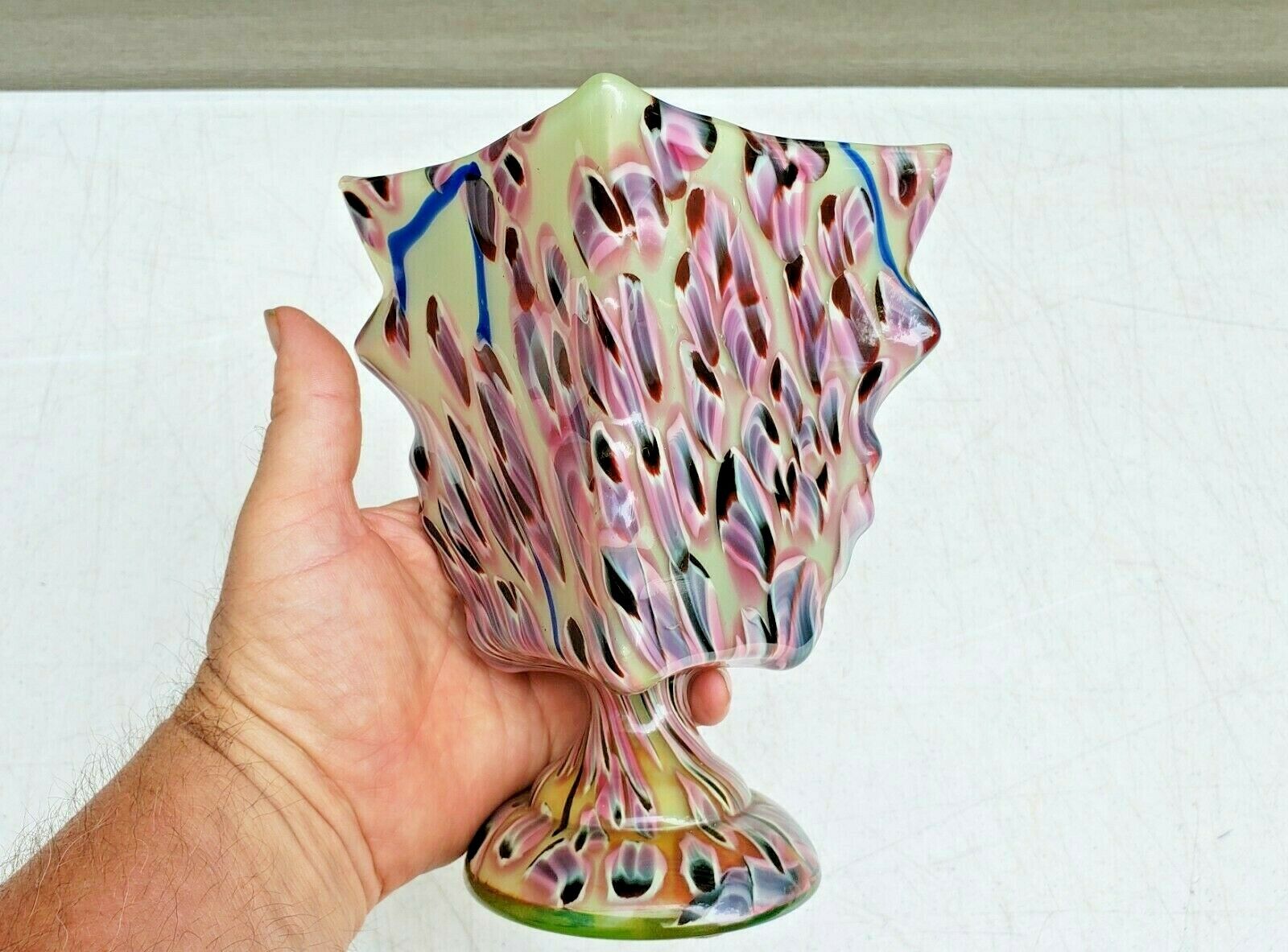-40%
Bohemian Czechoslovakia Ruby Red KRALIK / STEINWALD Art Deco Glass Trophy Vase
$ 79.2
- Description
- Size Guide
Description
This marvelous Bohemian Art Deco vase is blown of ruby red glass.The trophy shaped vase with flared rim has colourless applied (leaf) handles.
Marked with semi-circle acid stamp, Czechoslovakia on the low footed base.
7-1/8" tall. The rim is 4-1/8" diameter. The base is 3" diameter. Handle to handle is 4-1/4".
Attributed to Bohemian glasshouse, Kralik or Ernest Steinwald.
Ernst Steinwald & Co. may be a new Bohemian glasshouse some collectors have never heard of, and that is because documentation has been found in the past year by a
devoted
glass researcher and collector from the Czech Republic. There's
definitely some new developments as information is
currently being
determined
through further research. Many examples with the Czechoslovakia semi-circle marks, those attributions have been mostly devoted to Kralik production for more than 30 years. In Collectible Bohemian Glass (1915-1945) Vol. II book by the Truitts, published in 1992, it is stated the Czechoslovakia semi-circle mark was only 60-70% accurate. With the new research material covering Ernst Steinwald & Co., it does reveal a good line up Art Deco shapes having the same Czechoslovakia semi-circle mark and these examples are no longer considered Kralik.
The wooden base is not included.
Professional shipping is used with much care.
Best offers and questions are graciously welcomed! :)
For more information about Ernst Steinwald & Co., read below. (ref.Bohemianglass.org)
The glassworks was founded in 1870 on the northern outskirts of Teplice by Ernst Steinwald (1844 - 4 November 1920), the son of Moses Steinwald and Elisabeth Steinwald.
The company was operated under the name "Ernst Steinwald".
Ernst Steinwald married Mathilde Steinwald, née Karpeles (1852 - 8.3.1926) and had 2 children with her: Oscar Steinwald and Hedwig Baum Hirsch.
On January 1, 1894, the brother of Ernst Steinwald's wife Josef Karpeles - business traveler (1855 - October 21, 1924) joined the company and the company changed its name to "Ernst Steinwald & Co.".
Both partners represented the company separately.
In 1914, the company employed 140 workers and focused on the production of colored luxury glass, lighting glass and assembly items.
After the death of Ernst Steinwald in 1920, Mathilde Steinwald was probably in charge of the company together with Josef Karpeles, but perhaps even then it was Hedwig's daughter.
After the death of Josef Karpeles (1924), his son Paul Karpeles probably took his place.
Unfortunately, there is a minimum of available information on the glassworks' production (Industrial and Financial Yearbooks Compass Austria-Hungary and later Czechoslovakia 1923-1938).
Several objects are part of the collections in the Glasmuseum Passau, in the Teplice Regional Museum, in the Museum of Glass and Jewelery in Jablonec and in the Houston Museum of Fine Arts.
Several pieces of information from the period press show that the glassworks around 1900 produced, among other things, colored iridescent glass, marbled glass, translucent glass, glass in various colors and spun glass.
From an advertisement in the book Kur- und Badestadt Teplitz-Schönau from 1930, it can be read that the glassworks was considered one of the oldest and leading Czech glassworks for the production of art glass.
Its production included: vases, jardiniers, bowls, baskets, jars, toilet sets, utility glass, special art glasses: Pastel, Aquarin and Flowerall,
also lighting glass of all kinds, everything from the cheapest pieces to the best art glass.
At that time, the glassworks had permanent showrooms in all major shopping centers around the world.
She has also participated in world exhibitions (eg Chicago 1933-4) and international fairs (eg in Leipzig).
It exported a significant part of its production to a number of countries, probably mainly to the USA.
Other decors were named: Osiris, Carinthia, Kaktee, Vesuvio and Bambus.
Currently, certainly the most famous decor Bamboo has been attributed so far, as well as many other decors of the glassworks W. Kralik.
The identification of other decors is not yet clear.
The production of so-called Tango glass was also significant at that time.
In 1930, the glassworks had more than 300 workers.
During the Second World War, the property of the glassworks was Aryanized.
At that time, the name Hedwig Baum Hirsch was mentioned at the Ernst Steinwald glassworks, but also at the Josef Rindskopf, Fischmann Söhne and Emmahütte Otto Löwy Mstišov glassworks.
More information will (perhaps) be added later.
--- a few more details:
Ernst Steinwald also owned and operated briefly (1877 - circa 1883?) The glassworks in Maltheuern (Záluží) - the previous owner was Adolf Kopp and the next owner became Edmund Kadlík (certainly at least since 1887) - so the glassworks produced luxury colored glass
In 1910, 6 long-term employees of the company (25-30 years) received medals from the Liberec Chamber of Commerce (Franz Neugebauer - metallurgist, Karl Schön - glass melter, Wilhelm Lorenz and Franz Tůma - master glass grinders, Franz Šedivý - carpenter of molds and Franz Bauchner - glass assistant)
1890 - an exclusive privilege was granted for a new type of decoration of hollow glass objects "Lace"
1891 - granted the exclusive privilege for the process and decoration of hollow glass objects by galvanic methods for flat and relief painting
Josef Günther - director of the glassworks (1914 received a medal)
Ernst Steinwald probably came to Teplice from Prague
















